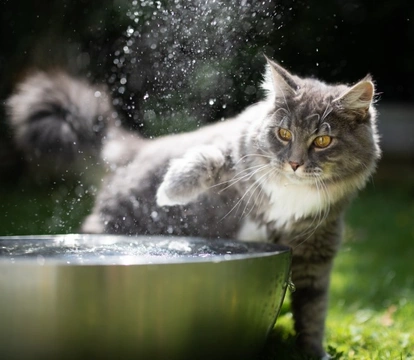
Can cats get heatstroke?
Heatstroke is also sometimes known as sunstroke, or heat exhaustion, and these are all terms that we use when person or animal overheats to the point that their own body temperature rises above the upper limits of the safe norms; and when this happens, even if exposure to the cause of heat itself is removed, it doesn’t tend to reverse on its own.
Heatstroke can happen very easily and surprisingly quickly, and it is actually a very dangerous condition that can, if not reversed quickly and in the right way, prove fatal.
Most people who own or know a little bit about dogs are very well aware of the threat of heatstroke in summer, and that in order to avoid it it is important to avoid walking their dogs at the hottest times of the day.
However, far less attention is given to the potential risk of heatstroke in cats, and many cat owners don’t even know that it can affect and be a danger to cats at all. This article will talk more about heatstroke and its risk to cats, how cats might get heatstroke, and how to identify heatstroke in a cat. Read on to learn more.
Can cats get heatstroke?
Yes, cats can get heatstroke, and every year, most UK vets will treat at least a couple of cases in it. Heatstroke in cats is definitely less common than heatstroke in dogs and even in people, both because cats tend to be a bit more sensible in this respect, and because they tend to roam freely and so avoid situations that may result in feline heatstroke.
What causes heatstroke in cats?
Heatstroke in cats occurs when they’ve overheated to the point that their body temperature exceeds around 40 degrees Celsius and stays there. The healthy normal body temperature for a cat is between 38.1 and 39.2 degrees; which is higher than for people, and means that cats are actually better equipped than us to manage the heat. This does not, however, mean that they cannot overheat or are heatproof!
Heatstroke in cats develops as a result of overheating, which is most likely to occur when a cat is unable to do the things and move to the places that allow them to cool down.
This might mean they cannot find water, cannot get out of full sun, or are forced to overexert themselves in the heat; such as if they’re chased by a dog and have to run.
Flat-faced cat breeds like the Persian overheat more easily than others, as they may have issues exchanging hot air for cool via respiration due to their narrower nostrils.
Heatstroke in cats usually occurs due to different situations than in dogs
Cat heatstroke can develop at any point that a cat overheats, and the sort of scenarios that cause this tend to be quite different than those that cause overheating in dogs.
This means it is wise for cat owners to be aware of some of the common causes and scenarios that can result in a cat overheating; and these tend to be things that take control away from a cat, as for instance, a cat is highly unlikely to continue to exercise while overheating unless they have to (such as if they are being chased) while dogs commonly will.
Some of the most common types of situations then that result in heatstroke in cats include being closed into rooms that get too hot so that they cannot seek shade and cooler places; having no access to water (due to being unable to get to their bowl or their bowl being empty); and being accidentally closed into a shed, greenhouse, or similar type of structure.
This latter, and other scenarios that result in cats getting trapped in summer, result in most of the cases of heatstroke in cats reported to vets, either requiring treatment or sadly, being the cause of death.
How would I know if my cat had heatstroke?
Cats that have heatstroke may not be willing or able to move or drink water and so cannot reverse heatstroke on their own. If this does occur, you must prioritise getting your cat to a vet immediately and reducing their temperature in the meantime, but without causing their body to go into shock.
This means things like laying them on wet, cool towels, but not using ice. Your vet will direct you further over the phone.
So, what are the signs that a cat has heatstroke? This varies based on the cat and the acuteness of the issue but will possibly include:
Rapid, shallow breathing.
Glazed or dull eyes.
Sticky mucous membranes or goo at the corners of the mouth.
Skin that does not spring back immediately when lightly pinched.
Possible drooling or vomiting.
At earlier stages, potential pacing and agitation (particularly if seeking to get away from heat or find water), and signs they’re upset or distressed. Never ignore this.
Cats may become unresponsive, unable to get up, and fall unconscious in short order once heat stroke begins to develop, if not reversed immediately.
Heatstroke in cats can be fatal; take steps to avoid it, recognise the signs, and intervene promptly if you have even a suspicion that something is not quite right.



